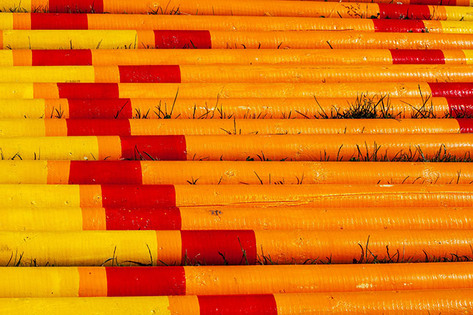
Are You & Your Horse Ready For Bitting Advice? The Steps You Need To Consider First
Equestrian Advice & Guides All Disciplines
Build your business profile for FREE and expose your services to thousands of potential clients!
Create my profile now!
Regardless of discipline, polework is an important part of horse riding. When completed regularly as part of your horse’s training schedule, polework builds your horse's strength and flexibility, engages their hindquarters and creates expressive, elevated paces.
This exercise, which uses eight poles, utilises walk, trot and canter along various routes (meaning you do not have to keep getting off to move the poles – bonus). Some routes over this pole layout are detailed below, all of which pose different challenges for both horse and rider. However, there is no limit as to the number of ways you can ride this exercise, meaning you can find your own riding lines and combine routes together.
 Route A can be performed in walk, trot or canter and encourages the horse to pick his feet up. To enhance this exercise, raise one or both sides of the pole. The exercise is also beneficial when introducing horses to angled jumps.
Route A can be performed in walk, trot or canter and encourages the horse to pick his feet up. To enhance this exercise, raise one or both sides of the pole. The exercise is also beneficial when introducing horses to angled jumps.
Route B can be ridden in walk, trot or canter, and will help maintain horse and rider straightness. When this line is ridden in canter, this exercise can be a constructive way to teach a horse not to rush, as they have to collect and concentrate of the poles.
Route C can be completed in walk, trot or canter. As with all the routes, this can be combined with the other riding lines. For example, you can ride this line in canter and then come around to ride through Route A.
Route D is a simple walk, trot or canter line. This can be used a warm-up line for the rest of the routes.
Route E is another straight walk or trot line (a shorter alternative to route A). Again, this is great way to introduce horses to an angled pole before raising the pole into a jump.

Route F is a curved line; this is great for encouraging your horse to bend laterally through their body, enhancing their suppleness. This route can be completed in walk, trot or canter. If your horse is new to this exercise, it may be beneficial to start with Route H and then increase the horses bend slowly to come over the shorter curve in Route F. These bends are a great exercise to help with your horse's impulsion in canter.
Route G can be completed in walk or trot; this is another exercise that is great for bending your horse and increasing their suppleness. As with all the exercises, it should be completed on both reins to building your horse’s muscles equally. You can also raise one or both sides of the poles to increase the challenge for your horse. Trying this route with two raised poles and two poles on the ground is great for keeping your horse’s brain engaged.
Route H is a curved walk, trot or canter line, which will increase your horses suppleness and impulsion, similarly to Route F.
Route I can be completed in walk, trot or canter and is great for combining straight lines over the poles with bending through the circle. As with all exercises, it is important this is completed equally on both reins.
Route J can be completed in walk, trot or canter. In canter, this route requires a very collected and controlled canter. When riding this route in canter, ask the horse to land on the correct leg in preparation for the next pole – for example, come into the first pole on the left lead and ask him to change to the right rein over the first or second pole.
There are many different ways to ride over these eight poles – why not try some transitions during the routes or incorporate some halts between the poles to ensure your horse is listening to you.

